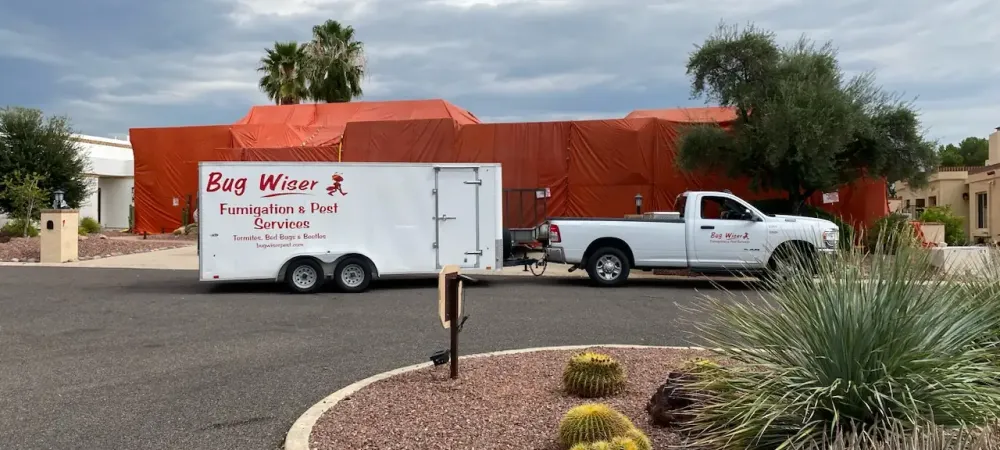Signs You Need Whole-house Fumigation

Whole-house fumigation, also known as tenting a house, is a highly effective method of pest control used to eliminate severe infestations of various types of pests, such as dry wood termites and subterranean termites. This process involves enclosing the entire structure of the home with a gas-tight tent and introducing a powerful fumigant called sulfuryl fluoride.
The arid climate of Arizona provides the perfect conditions for termites and other pests that may require fumigation. The hot and dry weather creates an ideal environment for these insects to reproduce and feed on wood. Additionally, the lack of rainfall reduces the availability of natural water sources, driving pests to seek shelter and moisture in homes. The abundance of natural vegetation further promotes their presence, as it provides them with food sources. Therefore, the climate in Arizona makes it highly susceptible to termite infestations and necessitates the use of fumigation methods to effectively eliminate these pests.
Whole-house fumigation is a highly specialized process that should only be performed by a professional fumigator. It is an effective solution for severe and challenging pest infestations, where alternative pest control measures may not be sufficient to eradicate the problem. However, consulting with a pest control expert is always recommended to determine if whole-house fumigation is necessary for your specific situation.
When You Need to Tent Your Home
If you're concerned about a pest infestation in your home, it may be time to consider tent fumigation. Here are five signs that indicate the need for this intensive pest control measure:
- Signs of Severe Infestation: Common signs of a severe infestation include visible pest activity, such as droppings or shed wings, and the presence of nests or tunnels. If you notice these signs around your home, it's a strong indication that the infestation has spread throughout the property.
- Structural Damage: Some pests, such as termites, can cause significant structural damage. If you discover hollow-sounding or weakened wood, sagging floors, or crumbling drywall, it's a clear sign that the infestation has already caused structural issues.
- Ineffectiveness of Other Methods: If you've tried alternative pest control measures, such as sprays or baits, and they haven't managed to eliminate the infestation, whole-house fumigation may be necessary. Certain pests, like dry wood termites or subterranean termites, can be challenging to eradicate without this method.
Remember, always consult with a licensed and professional fumigation or pest control company to properly assess the severity of the infestation and determine if whole-house fumigation is necessary.
How To Prepare Your Home for Fumigation
Preparing your home for fumigation is an essential step to ensure the success of the process and the safety of your family and pets. Here are some important steps to follow:
- Find alternative lodging: Before the fumigation process, it is crucial to make arrangements for you, your family, and any pets to stay elsewhere. You may need to book a hotel room or stay with a friend or family member. Make sure to plan for the duration of the fumigation, as it can usually last for a few days.
- Open doors and windows: On the day of the fumigation, open all interior doors, cabinets, closets, and drawers. This will allow the fumigant to penetrate every corner of your home and eliminate any pests.
- Move food items: Remove all food items, including packaged goods, from your kitchen and pantry. Seal them tightly and store them in a secure place away from the fumigation area. Discard any open containers or perishable items to prevent contamination.
- Prune plants: Trim back any plants or shrubs that are touching your home's exterior. This will create a buffer zone and minimize the chances of pesticide exposure to your vegetation.
- Schedule gas shutoff: Coordinate with your gas company to schedule a shutoff during the fumigation. This step is crucial to prevent any potential fire hazards, especially if your home has pilot lights or gas appliances.
By following these steps, you can ensure that your home is properly prepared for fumigation, enhancing the effectiveness of the treatment and minimizing any risks involved. Remember to consult with a licensed home fumigation or pest control expert for specific instructions and recommendations tailored to your situation.
